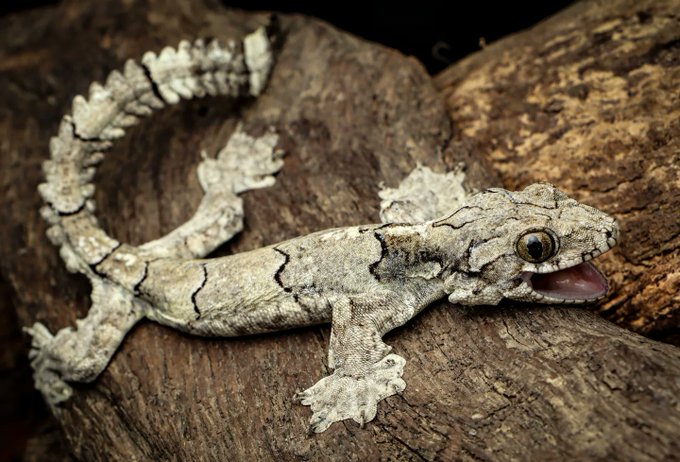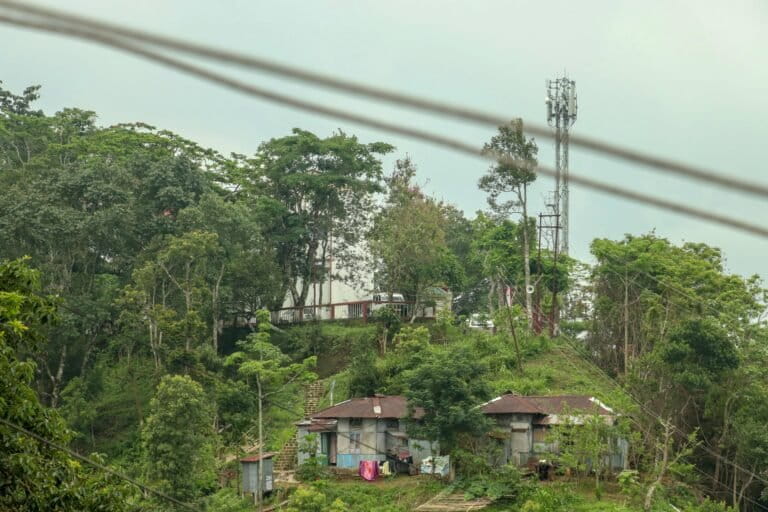- Using DNA analysis, researchers reported a species of parachute gecko, new to science, from southern Mizoram.
- Parachute geckos have elaborate skin flaps that facilitate gliding flight and enhance camouflage; they are active at night, gliding from one tree to another.
- Northeast India is understudied for its biodiversity; researchers suggest more funding for students pursuing their graduate degree projects in the region.
In 2001, researchers reported sighting the smooth-backed parachute gecko in southern Mizoram. It was the first time that this gecko, identified as Gekko lionotum, was reported to be present in India after it was recorded in Myanmar.
The team collected an individual and kept it in captivity for four and a half months, during which they monitored its behaviour. The gecko feasted on cockroaches and moths. During the daytime, the animal remained motionless but at night it became active and the researchers observed that on some occasions, it launched itself into the air and fell to the ground.
Parachute geckos or gliding geckos belong to the subgenus Ptychozoon of which there are 13 species found throughout Southeast Asia. Nocturnal by nature, these arboreal geckos paraglide from one tree to another, with a lifestyle that revolves around crypsis, the ability to camouflage or conceal themselves.
Over the past decade, researchers managed to generate DNA sequences from many populations present in Asia, finding that Gekko lionotum is a species complex containing more than one species. However, they look pretty much identical so without DNA it was very difficult to identify them.
Until recently, this gecko population from southern Mizoram remained unexplored. Zeeshan Mirza, a biologist pursuing his doctoral degree at the Max Planck Institute for Biology in Tübingen, Germany, suspected that the population found in Mizoram is not Gekko lionotum. He got in touch with his collaborator Hmar Tlawmte Lalremsanga, Head of the Department of Zoology at Mizoram University, who happened to have tissue samples.
After the researchers sequenced the DNA from the samples, they found that indeed it was a new species to science, which they aptly named Gekko mizoramensis after its location and suggested its common name as Mizoram parachute gecko. The finding was published last month in Salamandra, the German Journal of Herpetology.

“It was not possible to do this in the past because more importantly there was no DNA data,” says Mirza, an author of the report, adding that it is very tricky to identify these lizards. There were, however, some clues from its appearance that suggested it might be different species.
“The most striking thing was that other related species have a beautiful stripe along the eye but this one did not have that stripe. Then this animal has sort of these pimple-like tubercle scales on the tail, which other species do not have. The number of tags on the side of the feet and all of those eventually added up,” Mirza explains.
The main confirmation however came through DNA, since these could be characteristics that are variable across populations or the same species, according to Mirza.
Cryptic colouration and behaviour
Over time, Lalremsanga and his students surveyed the area and managed to generate a distribution map of the species, which appears to be sparsely distributed throughout the state of Mizoram. Its cryptic colouration and behaviour make the gecko elusive, state the researchers. The specimens were collected only from Lawngtlai town—the capital of the Lawngtlai district located in southern Mizoram—particularly during the monsoon season in the state.

The Gekko mizoramensis species is about 20 centimeters in length. After dusk, these geckos hunted or ambushed their prey consisting of beetles, roaches, moths and other insects attracted by light sources. If the geckos are disturbed, they tend to respond aggressively; they tried to bite the researchers when handled.
“This was an interesting paper. These geckos are hard to find because of their cryptic behaviour and camouflage,” says Lee Grismer, a herpetologist at La Sierra University in California, who was not involved in the study.
Calling this an “incredible find” from northeast India, he says this species is most closely related to a bizarre species of parachute gecko from Mount Popa, an extinct volcano in the middle of the Ayeyarwady Basin in Myanmar. Grismer notes that “their separation by the Chin Hills [Arakan Hills] on the border of Myanmar and India means there should be more to find.”
Gekko mizoramensis is genetically most similar to its sister species, Gekko popaensis, from which it differs by 7–14% sequence divergence along with distinct differences in morphology and colour pattern, the study found. The Arakan Hill range running north to south between the Indian subcontinent and Myanmar may function as a biogeographic barrier separating these two species from each other.
Parachute geckos have fascinating adaptations such as elaborate skin flaps along the head, body, limbs and tail that help in gliding flight. Enlarged skin flaps also enhance camouflage with the tree trunk. Although the mechanism is not clear, Mirza says he has heard that “during the day this lizard remains motionless on tree trunks and tries to move wherever there is a shadow so if there’s sun it keeps moving away from the sun” and “the skin flaps sort of cling to the tree trunk and does not cast a shadow.”
Exploring the hidden species of the northeast
Over the past five years, many reptile species have been discovered from northeast India. Lawngtlai district lies in southern Mizoram, which is part of the Indo-Burma biodiversity hotspot—one of 36 other biodiversity hotspots around the world.
“The study shows how little we know about the lizards of India, especially northeast India,” says Aravind Madhyastha, senior fellow and convenor at Ashoka Trust for Research in Ecology and the Environment (ATREE), who was not a part of this study. The northeast, he notes, has a unique biogeography, and shares many plant and animal species with Southeast Asia and China. “The use of integrated molecular techniques and extensive field surveys will surely yield many more species new to science and also biogeographically interesting species,” adds Madhyastha.
In June 2019, Mirza and his colleagues spent a one-and-a-half months traveling across the state of Arunachal Pradesh, which led to the discovery of three new snake species (a pit viper, a burrowing snake and a snail-eating snake), two new species of bent-toe geckos and an entirely new skink genus. “This is a lot in just one trip and we are still working on more papers from that one trip,” he says. “The northeast is blessed.”
One of the major threats faced by this new gecko species is collection by humans, says Mirza. Many people have been capturing tokay geckos to sell because of its use in traditional Chinese medicine. As a result, this species has also been collected. “I heard of multiple individuals being confiscated in Siliguri. So Siliguri is north Bengal; imagine this gecko had been captured and taken till there,” he says, adding that researchers do not have data on how many of these animals have been captured.
When people realize they cannot be sold, they release them. “In 2001, it was only known from southern Mizoram. And now if you see, it is more widespread, whether it is the natural distribution or whether it is taken there by humans, we do not know,” says Mirza.

“With more development, we are getting access because the northeast was not accessible in the past,” reveals Mirza. “Even now being very honest, during the monsoon many areas get flooded and are hard to reach so even when we wanted to survey more parts of Arunachal we couldn’t because they were disconnected because of the monsoons.”
In order to better study northeast India, Mirza suggests greater funding opportunities for students who wish to do their master’s or doctoral projects exploring the herpetofaunal diversity of northeast India.
Read more: [Explainer] What is molecular ecology and how does it help in conservation?
Banner image: A juvenile Gekko mizoramensis. Photo by Lal Muansanga.
